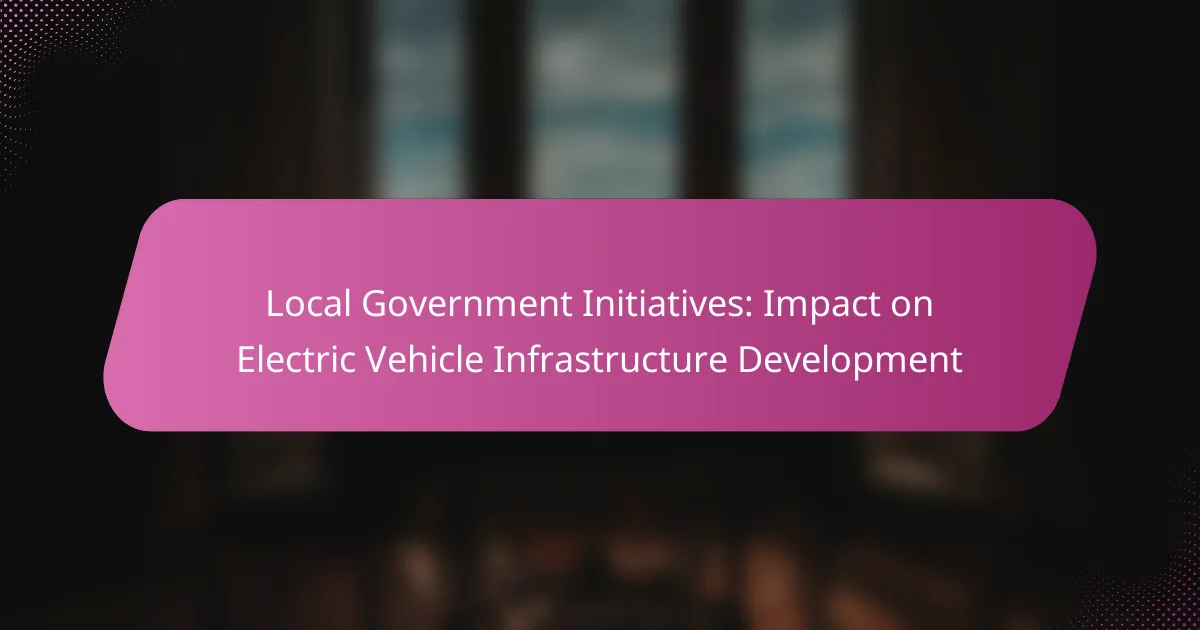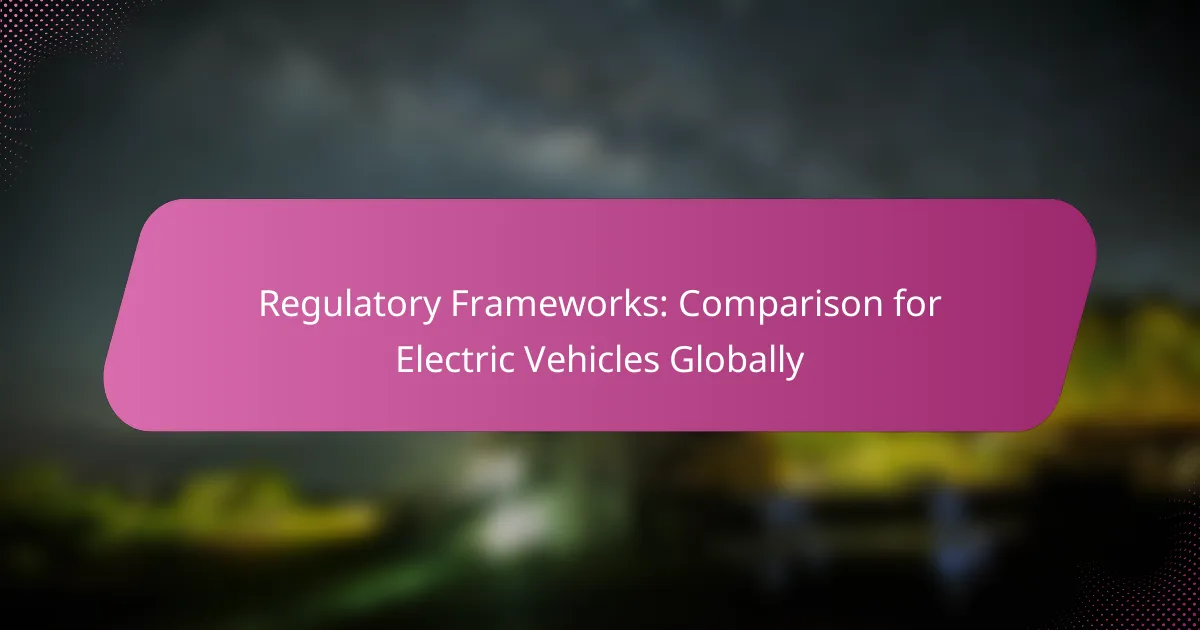Local government initiatives play a crucial role in advancing electric vehicle (EV) infrastructure, particularly in urban areas like Los Angeles. By increasing the number of charging stations and collaborating with private entities, these initiatives aim to meet the rising demand for EVs and promote sustainable transportation. However, challenges such as budget constraints and regulatory hurdles can hinder the effectiveness of these efforts.
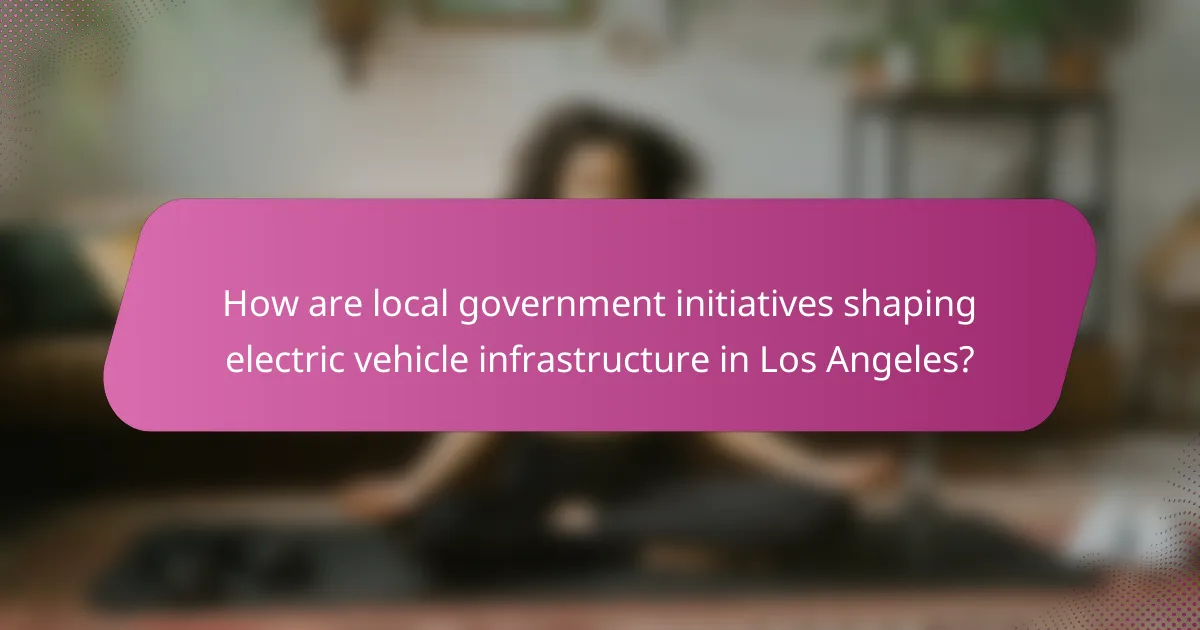
How are local government initiatives shaping electric vehicle infrastructure in Los Angeles?
Local government initiatives in Los Angeles are significantly enhancing electric vehicle (EV) infrastructure by increasing the number of charging stations and fostering collaborations with private companies. These efforts aim to support the growing demand for EVs and promote sustainable transportation options across the city.
Increased charging station installations
The City of Los Angeles has committed to expanding its network of EV charging stations to accommodate the rising number of electric vehicles. This includes installing chargers in public areas, residential neighborhoods, and commercial zones, making it more convenient for EV owners to charge their vehicles.
As part of this initiative, local authorities are focusing on ensuring that charging stations are accessible and strategically placed. For instance, they are targeting locations near public transit hubs and popular destinations to maximize usage and convenience for residents and visitors alike.
Partnerships with private companies
Local governments in Los Angeles are actively forming partnerships with private companies to enhance EV infrastructure development. These collaborations often involve sharing resources, funding, and expertise to accelerate the deployment of charging stations and related technologies.
For example, partnerships with utility companies can facilitate the installation of fast chargers, while collaborations with tech firms may lead to the development of user-friendly apps that help drivers locate available charging stations. Such initiatives not only improve infrastructure but also create a more integrated and efficient EV ecosystem in the city.

What funding sources support electric vehicle infrastructure development?
Funding for electric vehicle (EV) infrastructure development primarily comes from federal grants, state-level programs, and private investments. These sources help cover the costs of installing charging stations and upgrading electrical systems to accommodate increased demand.
Federal grants and incentives
The federal government offers various grants and incentives to promote electric vehicle infrastructure. Programs like the Charging and Fueling Infrastructure Grant Program provide funding to local governments and organizations for developing EV charging stations.
Additionally, the federal tax credit allows businesses to claim a percentage of the costs associated with installing EV chargers. This can significantly reduce the upfront investment required for infrastructure development.
State-level funding programs
Many states have established their own funding programs to support electric vehicle infrastructure. These can include grants, low-interest loans, and rebates specifically aimed at municipalities and private enterprises looking to install charging stations.
For example, California has a robust program that allocates millions of dollars annually to expand its EV charging network. States often tailor their funding to local needs, so it’s essential to check specific eligibility criteria and application processes.
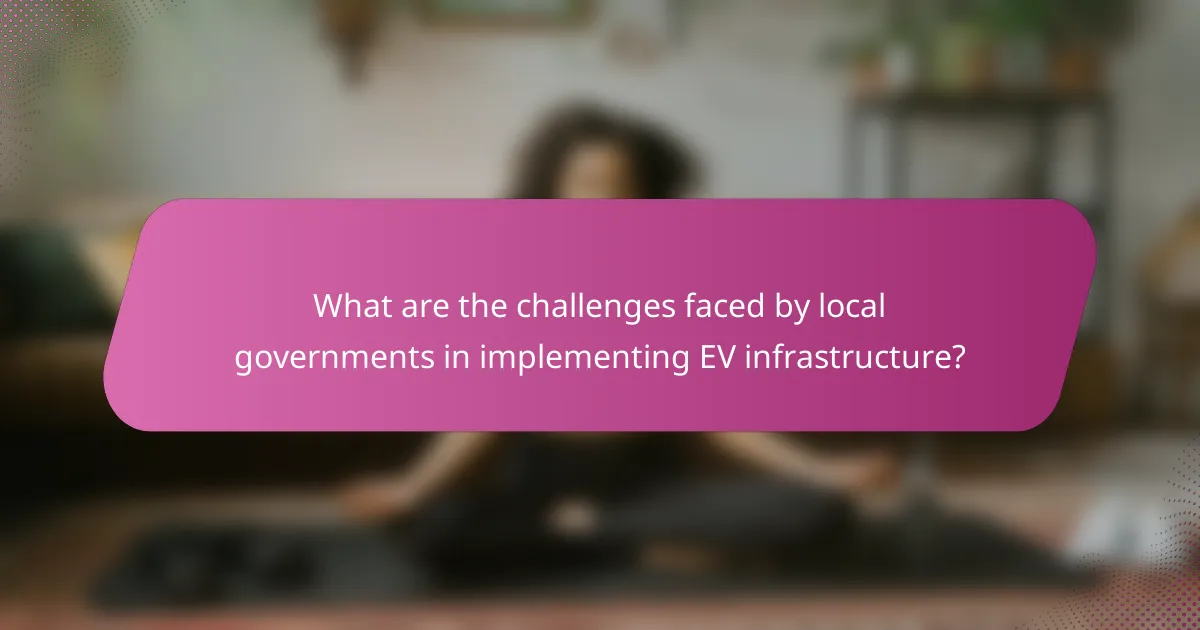
What are the challenges faced by local governments in implementing EV infrastructure?
Local governments encounter several challenges when implementing electric vehicle (EV) infrastructure, including budget constraints, regulatory hurdles, and public acceptance. These factors can significantly impact the pace and effectiveness of developing the necessary charging networks to support EV adoption.
Budget constraints
Budget constraints are a primary challenge for local governments in developing EV infrastructure. Limited financial resources can hinder the ability to invest in charging stations, maintenance, and upgrades. Many municipalities operate under tight budgets, making it difficult to allocate funds specifically for EV initiatives.
To address budget issues, local governments can explore various funding sources, such as federal grants, state incentives, and public-private partnerships. For instance, programs like the U.S. Department of Energy’s EV Charging Program provide financial assistance to localities aiming to expand their charging networks.
Regulatory hurdles
Regulatory hurdles can complicate the implementation of EV infrastructure. Local governments must navigate a complex landscape of zoning laws, building codes, and utility regulations that may not have been designed with EV charging in mind. These regulations can delay projects or increase costs significantly.
To overcome these hurdles, local governments should engage with stakeholders, including utility companies and community members, early in the planning process. Streamlining permitting processes and updating outdated regulations can facilitate smoother project execution and encourage investment in EV infrastructure.

How do local policies influence electric vehicle adoption?
Local policies play a crucial role in shaping electric vehicle (EV) adoption by providing financial incentives and establishing the necessary infrastructure. These initiatives can significantly lower the barriers to entry for consumers and businesses, making EVs more accessible and appealing.
Incentives for EV purchases
Local governments often offer incentives such as tax credits, rebates, or grants to encourage the purchase of electric vehicles. These financial benefits can range from a few hundred to several thousand dollars, depending on the region and specific policy. For instance, some cities may provide additional perks like reduced registration fees or access to carpool lanes.
To maximize the benefits of these incentives, potential EV buyers should research local programs and understand eligibility requirements. It’s essential to stay updated on any changes in policy, as these can affect the overall cost of ownership and the decision to switch to an electric vehicle.
Zoning regulations for charging stations
Zoning regulations significantly impact the development of charging infrastructure for electric vehicles. Local governments can facilitate or hinder the installation of charging stations through land-use policies that dictate where these facilities can be located. For example, areas designated for commercial use may have more lenient regulations, allowing for a higher concentration of charging stations.
When planning for EV infrastructure, municipalities should consider integrating charging stations into new developments and retrofitting existing properties. Collaborating with private companies can also enhance the availability of charging options, ensuring that residents have convenient access to EV charging facilities. Understanding local zoning laws is crucial for stakeholders aiming to expand EV infrastructure effectively.

What role do community engagement initiatives play in EV infrastructure?
Community engagement initiatives are crucial for developing electric vehicle (EV) infrastructure as they foster public support, inform residents about benefits, and encourage participation in planning processes. By involving the community, local governments can better align EV infrastructure with the needs and preferences of residents, leading to more effective implementation.
Public awareness campaigns
Public awareness campaigns are designed to educate residents about the advantages of electric vehicles and the importance of supporting EV infrastructure. These campaigns often utilize various media channels, including social media, local newspapers, and community events, to reach a broad audience.
Effective campaigns may include informational workshops, demonstrations of EV technology, and testimonials from local EV owners. By highlighting potential savings on fuel and maintenance, as well as environmental benefits, these initiatives can significantly increase public interest and acceptance of EVs.
Stakeholder collaboration
Stakeholder collaboration involves partnerships between local governments, businesses, and community organizations to develop and enhance EV infrastructure. This collaborative approach ensures that diverse perspectives are considered, leading to more comprehensive and inclusive planning.
For example, local governments can work with utility companies to identify optimal locations for charging stations and with businesses to provide incentives for installing EV chargers. Engaging stakeholders early in the process helps to address concerns, streamline approvals, and secure funding, ultimately accelerating infrastructure development.

How do local governments measure the impact of EV infrastructure initiatives?
Local governments assess the impact of electric vehicle (EV) infrastructure initiatives through various metrics, including usage statistics of charging stations and public adoption rates. These measurements help determine the effectiveness of investments and inform future planning and policy decisions.
Usage statistics of charging stations
Usage statistics provide insight into how frequently charging stations are utilized, which can indicate the demand for EV infrastructure. Local governments often track the number of charging sessions, duration of use, and peak usage times to understand patterns in consumer behavior.
For example, a charging station with high utilization rates may suggest that additional stations are needed in the area. Conversely, low usage might prompt a review of the station’s location or accessibility. Tracking these statistics can help optimize the placement and number of charging stations.
Surveys on public adoption rates
Surveys measuring public adoption rates gather data on how many residents are using electric vehicles and their perceptions of charging infrastructure. These surveys can reveal barriers to adoption, such as concerns about charging availability or range anxiety.
Local governments can use this information to tailor their initiatives, such as increasing public awareness campaigns or enhancing charging station accessibility. Understanding public sentiment is crucial for fostering a supportive environment for EV adoption and infrastructure development.
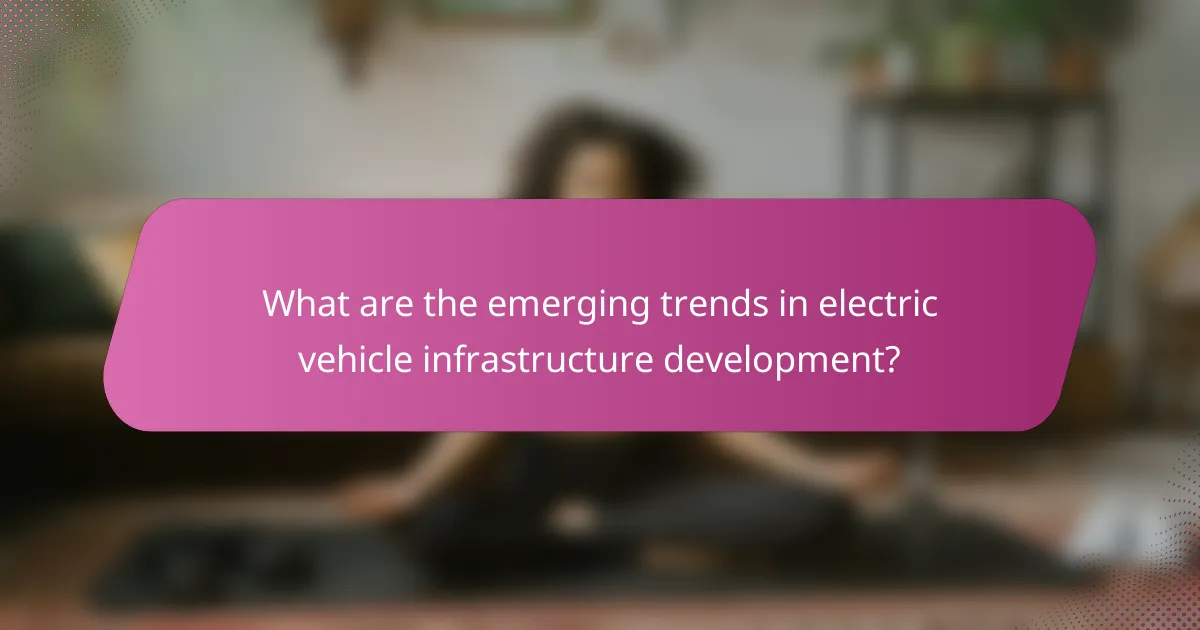
What are the emerging trends in electric vehicle infrastructure development?
Emerging trends in electric vehicle (EV) infrastructure development focus on enhancing accessibility, efficiency, and sustainability. Key areas include the integration of renewable energy sources, the application of smart city technologies, and the expansion of charging networks to meet growing demand.
Integration with renewable energy sources
Integrating renewable energy sources, such as solar and wind, into EV infrastructure is becoming increasingly common. This approach not only reduces the carbon footprint of charging stations but also helps stabilize energy costs by utilizing locally generated power.
For instance, solar-powered charging stations can significantly lower operational expenses and provide energy independence. Municipalities are encouraged to explore partnerships with energy providers to develop systems that allow for energy storage and grid balancing, ensuring a reliable power supply.
Smart city technology applications
Smart city technologies are enhancing the efficiency of EV infrastructure through real-time data collection and management. These technologies facilitate better traffic management, optimize charging station locations, and improve user experience by providing information on charging availability and wait times.
Examples include mobile apps that guide users to the nearest available charging station and smart grids that manage energy distribution based on demand. Cities should consider investing in these technologies to create a seamless and user-friendly EV ecosystem, ultimately encouraging more residents to adopt electric vehicles.
